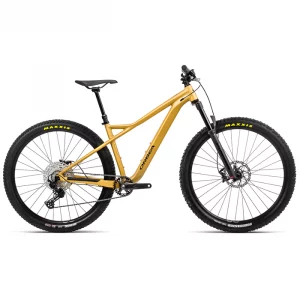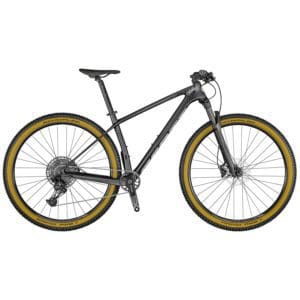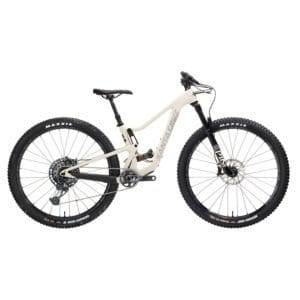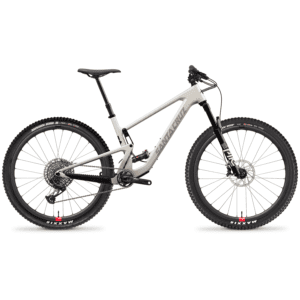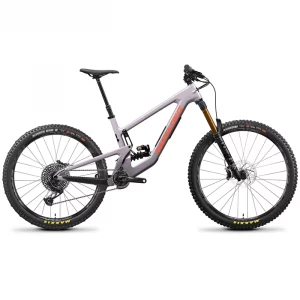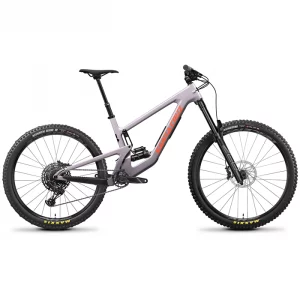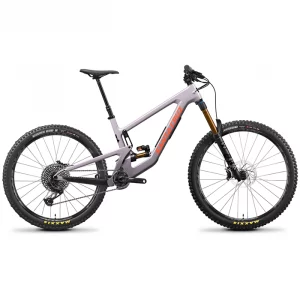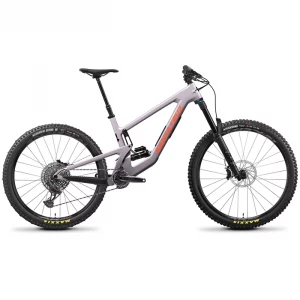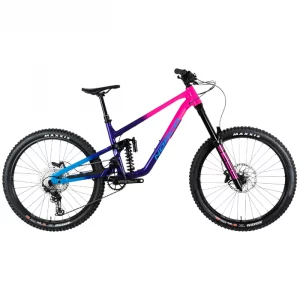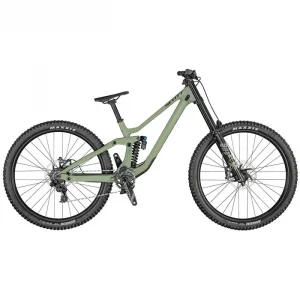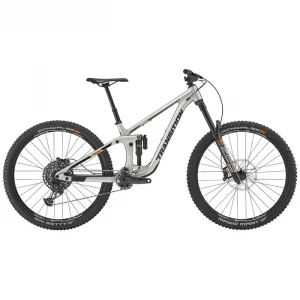|
Getting your Trinity Audio player ready...
|
Mountain biking has evolved since the 1980s with new technologies and designs. To get the most out of your hard earned money, it’s important to understand mountain bike design and be honest about your riding style and ability, as well as the type of trails you’ll ride most. Once you settle on a bike type, there are more factors to consider, from price to individual parts. We’ll help you choose the right bike for you and the way you ride.
The sport of mountain biking has evolved dramatically since the first mass-produced mountain bikes in the 1980s. Today’s mountain bikes are incredible machines that are purpose-built for incredible confidence and fun on all different types of trails. New technologies and designs have made this possible, but it also makes your decision of how to choose a mountain bike more complicated. To get the most out of your hard-earned dollars, it’s important to understand the basics of mountain bike design and be honest about your own riding style and ability as well as know what kinds of trails you’ll be spending most of your time on. Once you’ve settled on the correct type of mountain bike, there are many more factors to consider, ranging from price to the individual parts that make up your bike. We’ll break down all of these factors, and more, helping you choose a mountain bike that is perfect for you and the way you ride.
Here’s evo’s buyer’s guide to choosing a mountain bike with an overview of the various bike types available:
Table of Contents
Article Navigation: Click on any of the listed items in the table of contents below to jump to that section of the article. Similarly, clicking on any large, white section header will jump you back to the Table of Contents.
- How to Choose a Mountain Bike
- Types of Mountain Bikes
- Mountain Bike Geometry & Specs
- Mountain Bike Sizing
- Mountain Bike Build Kits, Components & Pricing
- Mountain Bike Components
- Testing & Demoing Mountain Bikes
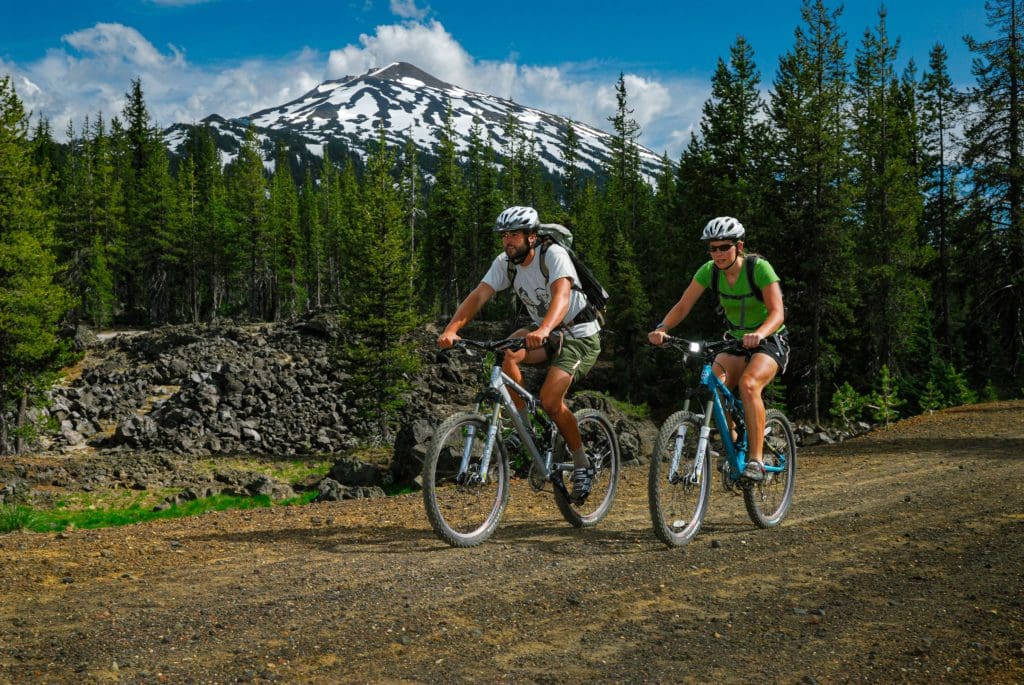
Mountain bikers traveling a dirt road under Mount Bachelor near Bend, Oregon.
How to Choose a Mountain Bike
- Choose the type of mountain bike that is right for you.
- Compare specs and stats across models.
- Determine which size will fit you best.
- Pick a build kit and components that fit your goals and budget.
- Ride some bikes! Demo models that you’re deciding between.
- Choose the mountain bike that lines up best with your budget and riding style.
So it looks simple when we list it out like this, right? But picking the right mountain bike might still seem daunting. First, we’ll assure you that there are so many good mountain bikes out there these days that it really is hard to go wrong. Gains and differences are often marginal, so focus on the important things that we outline below, and remember what the goal is – having fun on the trails. So don’t stress the details and go ride!
Types of Mountain Bikes
So what’s the deal with all these mountain bike styles these days? While there are plenty of different terms manufacturers use to describe their bikes, there are 4 basic types: Cross Country (XC), Trail, All Mountain (Enduro), and Downhill (DH).
Cross Country (XC)
Cross country mountain bikes are built for riders who want pedaling performance as their top priority. These are uphill crushing, lung-busting machines bred for endurance and efficiency. The geometry of cross country bikes is the most similar to road bikes. The focus on efficiency and lightweight doesn’t come without tradeoffs, however, cross country bikes trade out downhill performance for efficiency and weight. Cross country mountain bikes are great for riders that are going to put in long miles pedaling, and those who prioritize climbing over descending.
Modern XC bikes are trending towards the largest mountain bike wheel size, 29”. This is the same rim diameter as the 700c road bike size.
Ultra-lightweight builds (less than 24 lbs. in some cases) with 4.7″/120mm or less of travel make for the lightest mountain bikes you’ll see anywhere.
Hardtails (front suspension only) can be preferential in this category in some cases.
Longer chainstays & wheelbases, steep head angles (69° or steeper) as well as longer stems put riders in efficient climbing positions.
Tires on these bikes are likely to favor reduced weight, efficiency and faster rolling resistance rather than traction, control or durability.
Here are a few of our favorite cross country mountain bikes:
Orbea Laufey H10 Complete Mountain Bike 2022
The Orbea Laufey H10 Complete Mountain Bike is as precise and quick as any carbon hardtail in the game, but has the no-nonsense durability of aluminum alloy. With its Marzocchi Bomber fork leading the way at a very comfortable 65.5 degrees, the Laufey H10 is stable at speed, easy to control, and even easier to push, encouraging you to seek out more aggressive terrain. You’ll love honing your skills with this refined hardtail.
Shop now!
Scott Scale 940 Complete Mountain Bike 2022
A triple shot of espresso in bicycle form, the Scott Scale 940 Complete Mountain Bike loves to move. It’s a carbon fiber hardtail racer with rock solid components, making it a great choice for competition or training. It’s not against having fun, though, as it absolutely flies on singletrack too. If you’re riding smooth terrain, there aren’t too many bikes that are faster.
Shop Now!
Santa Cruz Bicycles Tallboy CC X01 Complete Mountain Bike 2021
The downhiller’s XC bike is back and better than ever! The Santa Cruz Bicycles Tallboy CC X01 Complete Mountain Bike has all the hallmarks of a Santa Cruz: aggressive geo, a pro-level parts build, and that lower-link VPP shock that’ll give any bike an appreciable boost in downhill prowess. This CC carbon Tallboy really leaves nothing to wish for, with the highest quality components and a build quality that’s second to none. As a 120mm bike that’ll definitely win some pedaling contests, it’s truly amazing how good this bike is in heavier terrain. The Tallboy is a marvel.
Shop Now!
Santa Cruz Bicycles Tallboy CC X01 Reserve Complete Mountain Bike 2021
The Santa Cruz Bicycles Tallboy CC X01 Reserve Complete Mountain Bike features the aggressive geometry and pro-level parts build that Santa Cruz bikes have become known for. The CC carbon frame is lighter than alloy and gives the bike an edge when tackling technical terrain. This all-mountain steed really leaves nothing to wish for, with the highest quality components and a build quality that’s second to none, especially since it will win some pedaling contests while conquering most descents.
Shop Now!
See All Cross Country Mountain Bikes
Top Adventure Sports Towns: Bend, Oregon
The variety of adventures in Bend, Oregon is what makes it such a stand-out adventure destination.
Trail Mountain Bikes
This category is what most people relate to when they think “mountain bike.” Trail bikes are the Swiss army knives of mountain biking and are both great climbers and capable descenders. Trail bikes add more suspension, more gravity oriented components (like chunkier tires for better traction and bigger brake rotors), and more relaxed geometry than their XC brethren to make them more capable on all kinds of terrain. Do you see yourself on all-day backcountry epic rides as well as banging around town and your local trails? Do you measure your rides in grins and smiles rather than seconds? If you’re into mountain biking uphill just as much as downhill and are looking for the occasional drop or jump, a trail bike is probably what you’re looking for.
Trail bikes come with 27.5” or 29” wheels. Suspension can be anywhere from 4.7″/120mm to 6″/150mm of travel (front and back).
Trail bike geometries are typified by “neutral” head angles (66° or 68°) but vary widely to suit different riding styles.
Tires on trail bikes will strike a balance between durability, traction and rolling efficiency.
Here are a few of our favorite trail mountain bikes:
Santa Cruz Bicycles Nomad CC X01 Coil Complete Mountain Bike 2023
Stable, reliable, fun-loving, adventurous, loves the outdoors — is it a Tinder bio or is it the new Santa Cruz Bicycles Nomad CC X01 Coil Complete Mountain Bike? The new Nomad is all of the above and more, with versatile mixed wheels and a Fox DHX2 coil shock for predictable suspension throughout your travel. The new Glovebox™ will hold your tools and smaller essentials and the SRAM X01 drivetrain shifts smoothly with a range that can get you up and down the trails. It’s not a catfish — the 2023 Nomad is the real deal.
Shop Now!
Santa Cruz Bicycles Nomad C R Complete Mountain Bike 2023
The Santa Cruz Bicycles Nomad C R Complete Mountain Bike is the bike everyone loves at a spec level most of us can get behind. High end features like the carbon frame and Glovebox™ storage system meet the killer performance and price point of the SRAM NX drivetrain and RockShox ZEB fork. Epic performance doesn’t have to break the bank, and thanks to the rock solid chassis and even more stable mixed wheels, it won’t break your bike either.
Shop Now!
Santa Cruz Bicycles Nomad CC X01 Complete Mountain Bike 2023
The Santa Cruz Bicycles Nomad CC X01 Complete Mountain Bike doesn’t really like limits. It’ll rip downhill without skipping a beat but it hides it’s beefy 170mm travel well when the terrain calls for pedaling. The top of the line carbon frame is light and stiff and the Fox Factory rear shock is plush at any speed. The new Glovebox™ will keep your essentials safe through the biggest hits and the new mixed wheel size finds the middle ground between stability and playfulness for a ride that’s unlike anything you’ve ever experienced.
Shop Now!
Santa Cruz Bicycles Nomad C S Complete Mountain Bike 2023
The Nomad is a classic in the trail meets enduro lineup, and the Santa Cruz Bicycles Nomad C S Complete Mountain Bike packs even more performance into the newest model. The carbon frame is light when you find yourself climbing and the SRAM GX eagle drivetrain is known for its epic performance at a reasonable price. The The Glovebox™ locks your snacks and tools in for the ride and the new mullet wheels prove that 27.5 wheels aren’t going anywhere, they just might be better off keeping your rear nimble and tight while the front smashes its way through any obstacle or side hit you see.
Shop Now!
See All Trail Mountain Bikes
Evo Reviews The 2023 Santa Cruz Hightower Mountain Bike
Evo’s Danielle Vilaplana recently rode the V3 Santa Cruz Hightower for three days in Oakridge, Oregon, with an impeccable team from Santa Cruz and Trans Cascadia Excursions.
All Mountain or Enduro Mountain Bikes
You could call this category the burly cousin of the trail bike. All-mountain bikes are the centerpiece of the race format called “Enduro,” where climbing is necessary, but only the downhill sections are timed and scored on. An all-mountain or enduro mountain bike is the perfect rig if you’re willing to earn your ride by pedaling up, but are really in it for the downhill with technical terrain and airtime in mind. That being said, if you want to skip the pedaling and do a couple of laps at a bike park or even some shuttle accessed terrain, an all-mountain bike can handle that too.
Enduro mountain bikes come with 27.5” or 29” wheels, or even mixed “mullet” sizes with 29” in the front and 27.5” in the rear.
All-mountain bikes have slightly more suspension travel than trail bikes, ranging from 5.5″/140mm to 6.7″/180mm.
Geometry strongly favors descending to climbing. Head angles in the 65°- 67° range can require some finesse when it comes to steep climbs.
Long wheelbase and reach, low bottom bracket and slack head angle are key terms when talking about modern all mountain/enduro geometry.
Tires on all mountain bikes are likely to favor aggressive knobs for cornering and traction since the important part of the ride is gravity assisted.
See All Enduro Mountain Bikes
Ride Freshly Reclaimed Singletrack At Mount Saint Helens
Experience the Mount Saint Helens blast zone and the amazing trails that inhabit the area with evoTrip’s partners at Trans-Cascadia.
Downhill & Freeride Mountain Bikes
Downhill bikes are designed for steep, gnarly terrain, speed, big drops, and jumps. With these bikes, you’re usually looking for some other way to the top of the trail whether that’s hiking, shuttling or a chairlift. They simply aren’t made to go any direction but down. If you’re not even remotely interested in pedaling uphill, have the trails & terrain to support high speeds and airtime, and the skill level to handle yourself in these situations, a downhill bike is what you’re looking for.
Burly frames sporting 6.7″/170mm – 10″/250mm+ of suspension travel in the rear and 7″/180mm – 8″/200mm in the front with dual-crown forks that resemble something you might see on a motorcycle.
These bikes tend to be extremely slack (less than 65° head angle) and sport a very low center of gravity (bottom bracket) for confidence on steep terrain and aggressive, brown-pow roosting corners.
Tires on downhill bikes are geared for traction and durability with 2-ply (think double-thick) casings for traction and durability.
Here are some of our favorite downhill & free ride mountain bikes:
Norco Shore A2 Complete Mountain Bike 2022
Vancouver’s North Shore was the cradle of freeride, and that borderline reckless vibe lives on in the Norco Shore A2 Complete Mountain Bike. This is a 180mm bike made for positive attitudes under questionable conditions, an aluminum bruiser meant for gamblers. Heavy duty in every sense of the word, it’s not going to win any climbing contests, but who cares about that when you’re riding in the back of a truck or on a bike park’s chairlift? Note: the paintjob is even more radical in person. Party laps all weekend!
Shop Now!
Scott Gambler 910 Complete Mountain Bike 2021
Clear your schedule, because you’re going downhilling! The Scott Gambler 910 Complete Mountain Bike weighs the same as all these enduro bikes with stuff strapped to their frames, making you really wonder what’s going on there. With this Gambler, there’s no denying the goal: out and out downhill speed. This bike is tunable in more ways than imaginable, from chainstays and BB to being a breeze to set up mullet or full 27.5″ (it comes as a full 29er). Eight inches of travel and under 40 pounds? Grab your fullface and hop in the truck!
Shop Now!
Transition Spire Alloy GX Complete Mountain Bike 2022
Oh, Showcase Showdown! Before you even have time to think, there’s a quick left turn that leads into a chunky traverse over the first rock roll. Feather your brakes a bit as you stretch up and peer over, looking to see if it goes. It does, you know it does, but it’s always hard to avoid hesitation. By the time you’re past the point of no return, you’re bracing for the dirt ramp back onto the trail surface. It’s gone, beaten down by a couple seasons of bottom-outs. You exhale as you smash through at warp speed, careening towards the next ridiculously steep triple-decker rocky chute-to-right handed catch berm. The Transition Spire Alloy GX Complete Mountain Bike was made for this trail: steep, rough, and fast. Hang on and let it flow.
Shop Now!
See All Downhill Mountain Bikes
Mountain Bike Geometry & Specs
Once you are in the right neighborhood, having chosen the type of mountain bike you want, how do you narrow down between the different bikes within these categories? Brand and price definitely factor in here, but if you want to be more scientific, you can compare geometry and specs. For a full breakdown of these measurements, check out our guide to mountain bike geometry. The key takeaway is, differences in specs like reach, head tube angle, and chainstay length influence the fit of the bike and the way it rides. If all of this talk sounds like a foreign language, your best bet is to write down some general notes on these differences, and go hit the trails! Actually riding a bike is the best way to see what works for you.
Mountain Bike Sizing
We have a full guide on mountain bike sizing, but here’s the gist – a properly fitting bike is essential to having a good time out on the trails. Start with a size chart, and work from there, and remember that sizing can vary between brands. Factors like riding style, body dimensions (long legs, short torso, etc.), and ability level all factor into sizing decisions. These are all good things to remember throughout the process of picking a mountain bike.
Mountain Bike Build Kits, Components & Pricing
Mountain bikes are complicated machines, they’re made up of tons of smaller pieces, or components as they’re called. These components not only have a huge influence on the performance of your ride, but they also have a big influence on the price of your bike. Unless you’re building up your bike from scratch these components come packaged with the frame as a “build kit.” One bike model from one manufacturer will usually have different build kits that hit different price and performance levels.
Mountain Bike Frame Material
The first thing to consider when looking at the spec and build of a bike, and sometimes the starting point for riders looking for a new mountain bike, is what the actual frame is made out of. For most mountain bikes, the decision is simple, aluminum alloy, or carbon fiber, though other materials like steel or titanium are rarer. Different materials have different ride characteristics and weight.
Carbon vs Aluminum Mountain Bikes
So, which frame material is superior? It’s complicated. There are tradeoffs with each. On a basic level, carbon fiber is lighter and stronger, but more fragile and expensive. Aluminum is cheaper and more durable, but heavier. As far as the quality of the ride, carbon fiber is damper and more torsionally stiff. Choosing a frame comes down to deciding which of these factors above are most important to you.
Mountain Bike Components
Building up from the frame, each component on the bike, from its wheels to suspension contributes to the final package. As you gain experience as a rider, you will likely gain more knowledge around these parts, and figure out what is most important to you. For example, some mountain bikers prefer the feel of a particular brand’s brakes or suspension over others. Generally, as you increase to the price of the bike, you get parts that are lighter in weight and give you better performance and adjustability. Choosing the correct kit for you comes mostly down to how picky you are about these parts and your budget.
The most important components to focus on are the drivetrain and suspension. Like different build kits on bikes, drivetrains come in different performance levels. These affect your gearing, shifting, and weight. Modern mountain bikes have eliminated the need for front derailleurs and come with 1x or “one by” drivetrains. As you increase in price across builds and drivetrains, you get lighter weight and more precise shifting performance. As for suspension, compare the models of fork and shock across bikes and builds. As you step up to nicer models, you get better performance (less friction) and more adjustability.
Testing & Demoing Mountain Bikes
It’s easy to obsess over every measurement and component of different models of mountain bikes when looking at them on a computer screen, but there is absolutely no substitute for some real time in the saddle. So, once you’ve narrowed down the candidates and you’re ready to choose your next mountain bike, it’s time to do some riding. Demoing a mountain bike is the only true way to get a feel for how it rides, and how it suits you. Each unique combination of geometry, design, and build gives a bike different characteristics that suit different riders best. Find what works for you!
When demoing a mountain bike, it’s good to ride trails that you’re already familiar with. This will help you focus on the bike and not route-finding or riding blind. Our favorite place to demo bikes is at skills parks rather than on big backcountry rides, this way you can ride a bunch of short laps, playing with settings or even trying out and comparing different bikes. Look for manufacturers demo tours or local mountain bike festivals for demos if you’re not in the area of an evo store.
If you’re not able to demo, the good news is that it’s pretty hard to go wrong these days, mountain bikes have gotten so good. Use the info above to make the best-informed decision you can, then go out and enjoy it!
Shop mountain bikes at evo!
Rental and demo bikes are available at evo Seattle, evo Portland, evo Denver, evo Whistler, evo Salt Lake, evo Snoqualmie Pass, and evo Hood River. (Note: The cost of up to three evo bike demos can be applied toward the final cost of purchasing a new or used bike from evo.)
The sport of mountain biking has evolved dramatically since the first mass-produced mountain bike in the 1980s. Today’s mountain bikes are incredible machines that are purpose-built for incredible confidence and fun on all different types of trails. To get the most out of your hard-earned dollars, it’s important to understand the basics of mountain bike design and be honest about your own riding style and ability as well as know what kinds of trails you’ll be spending most of your time on. Once you’ve settled on the correct type of mountain bike, there are many more factors to consider, ranging from price to the individual parts that make up your bike. Evo breaks down all of these factors, and more, helping you choose the best mountain bike for you and your trails.
About evo
evo explores the collaboration between culture and sport by seamlessly joining art, music, streetwear, skateboarding, snowboarding, skiing, mountain biking and wakeboarding. Evo’s aim is to bring all things relevant to the urban, action sports lifestyle into one creative space. Whether it is on the website, on the phone or in their stores, evo’s aim is to make all who come into contact with evo feel welcome and excited about their experience.
Evo’s website launched in 2001, after lots of coffee, countless late nights, 100’s of powder days, and early morning sessions on the lake, they are still focused on being a great retailer and asset to the community. evo’s retail locations in Seattle, Portland, and Denver are more than just stores – evo is passionate about creating community anchors in urban settings with diverse groups of people who share common interests. Music events, movie premiers, art exhibitions, benefits to help children in need, partnerships and simply providing a great place in a central location are all ways that they work to build and strengthen community. It is no mistake that evo’s locations are venues, art galleries, and retail spaces all wrapped into one.
Learn more here:
Video: Mountain Bike Upgrades & Modifications
Video: Mountain Bike Sizing, Fit, and Geometry
Popular Articles:
Evo Reviews The 2023 Santa Cruz Hightower Mountain Bike
Evo’s 8 Best Mountain Bikes of 2022





